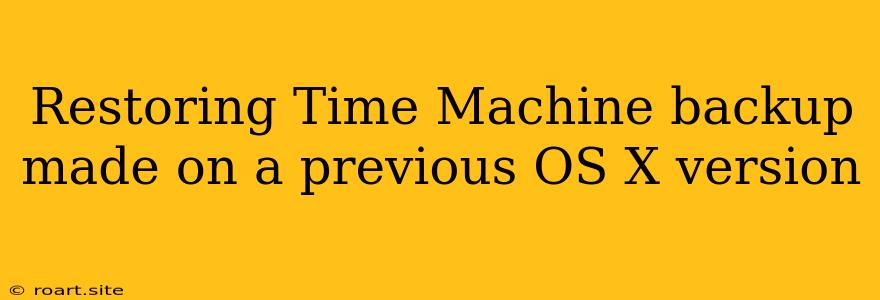Restoring a Time Machine backup made on a previous OS X version can be a complex process, but it is possible with the right steps. This situation can arise if you've upgraded your macOS to a newer version, or if you're trying to restore a backup from an older Mac. While Time Machine is designed to be a seamless backup solution, there can be compatibility issues when dealing with different operating system versions. This article will guide you through the process of restoring a Time Machine backup made on a previous OS X version, highlighting the challenges and solutions involved.
Understanding the Challenges
The primary challenge in restoring a Time Machine backup from a previous OS X version lies in compatibility. macOS has evolved significantly over the years, introducing new features, file systems, and even hardware requirements. A backup from a significantly older OS X version may contain data that's not fully compatible with the newer system. This can lead to various issues, including:
- Application Compatibility: Older applications might not work properly or at all on a newer macOS.
- File System Differences: The file system structure of macOS has changed over time. A backup from an older system might not be easily readable by a newer macOS.
- Driver Compatibility: Older drivers designed for older hardware might not be compatible with newer macOS versions.
Preparing for the Restoration
Before diving into the restoration process, it's crucial to prepare:
1. Check for Compatibility:
While Time Machine backups can often be restored across different macOS versions, the best way to ensure compatibility is to check if your backup is from a compatible version. If you're unsure, consult Apple's official documentation or search for information on the specific OS X version your backup was created from.
2. Back Up the Current System:
Before restoring from a Time Machine backup, it's critical to back up your current system. This ensures you have a fallback option in case the restoration process fails or results in unexpected data loss. You can use Time Machine itself or other backup methods to create a backup of your current macOS.
3. Understand the Restoration Options:
Time Machine offers different restoration options. You can choose to restore your entire system, individual files and folders, or even just specific applications.
Restoring from a Time Machine Backup
Here's a step-by-step guide to restoring a Time Machine backup made on a previous OS X version:
- Connect the Backup Drive: Connect the external drive containing your Time Machine backup to your Mac.
- Launch Time Machine: Open Time Machine by clicking the Time Machine icon in the menu bar or by accessing it through System Preferences.
- Select the Backup Drive: Choose the backup drive you want to restore from.
- Choose the Restore Option: Depending on your needs, you can choose to restore the entire system, individual files, or specific applications.
Important Note: Restoring an entire system from a previous OS X version will overwrite your current macOS and install the older operating system. If you're not comfortable with this, choose a more targeted restoration option.
Addressing Compatibility Issues
During the restoration process, you may encounter compatibility issues. Here are some strategies to address them:
- Upgrade to the Latest OS X: If the backup is from an extremely outdated OS X version, consider upgrading your current macOS to a more recent version. This can improve compatibility with older backups.
- Use Migration Assistant: Migration Assistant is a built-in macOS tool designed to transfer data from one Mac to another. It can help migrate data from an older backup, even if the operating systems are different.
- Manually Transfer Data: If you encounter specific issues with certain files or applications, you can manually transfer them from the backup drive to your current Mac.
Post-Restoration Steps
After restoring from a Time Machine backup, it's crucial to perform some post-restoration tasks:
- Update Applications: After restoring, make sure to update all your applications to the latest versions compatible with your current macOS. This helps ensure optimal performance and security.
- Check for Data Integrity: Verify that all your essential data has been restored correctly. Check your documents, photos, and other important files.
- Configure Settings: Re-configure your system settings, including network connections, user preferences, and security settings.
Conclusion
Restoring a Time Machine backup made on a previous OS X version can be a complex process due to compatibility challenges. By understanding the potential issues and following the steps outlined above, you can successfully restore your data and applications from an older backup. However, it's essential to back up your current system before starting the restoration process to ensure you have a fallback option in case of any unexpected problems. Remember, restoring a Time Machine backup made on a previous OS X version requires patience, planning, and some technical understanding. With careful planning and the right approach, you can successfully recover your essential data and get back on track.
